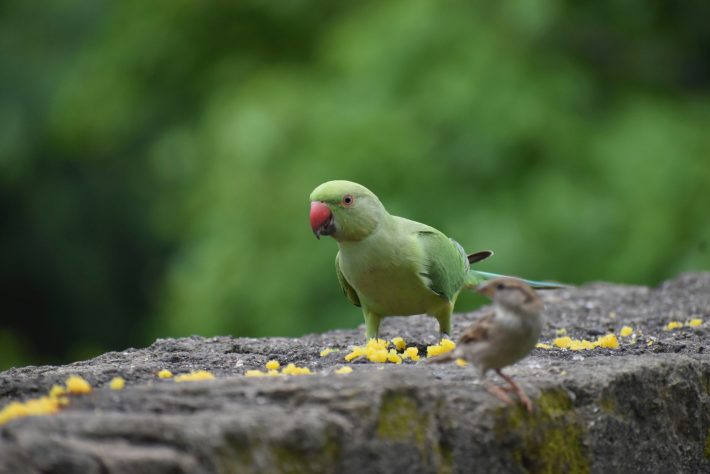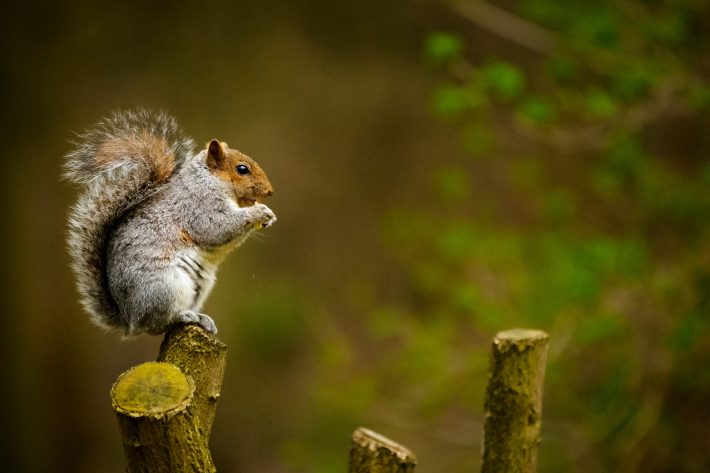Invasive Species Week: UK Invasions in a Changing Climate
In an Invasives Species Week special, Jane Catford and Regan Early discuss the possible synergies between climate change and the spread of invasive species.

Whether it is parakeets streaking across the sky, grey squirrels pirouetting in your local park, or seed pods of Himalayan balsam going pop, alien species are familiar sights and sounds in the UK.
Last week’s release of the IPBES report and this week’s Invasive Species Week remind us of the serious threat posed by alien species that become invasive. Not only do they impact the economy – costing the UK some £1.8 billion each year, threaten human health and degrade cultural values, but they are the fifth biggest threat to biodiversity globally.
Together with the BES policy team, we recently responded to Parliament’s Invasive Species inquiry.
Among the questions the Inquiry posed was whether climate change would exacerbate invasions. Would the two interact to make a problem bigger than the sum of its parts?
Increasing number of invaders under climate change
Somewhat surprisingly, the way that climate change will affect UK invasion is yet to be comprehensively assessed. Evidence suggests it’s unlikely that numbers of invasive species will increase simply because the UK climate will become suitable for species that otherwise couldn’t live here. Rather, more invaders may arrive in the UK because their populations grow in mainland Europe, and through human responses to climate change1.
If climate change makes invaders more abundant in continental Europe, the number of emigrants will increase, driving up immigration into the UK2. For example, numbers of moths migrating each year to the southern UK (but not establishing populations) has increased by 1.3 species/year, associated with warming temperatures in Spain and France3, but there is no direct evidence that climate change is the cause.
Greater use of biofuels, more intensive agriculture, and introduction of new plant species (or plant varieties) for gardens and agriculture may help us mitigate or adapt to climate change, but may inadvertently facilitate invasion4,5. New varieties of pasture plants that grow quickly and can cope with varying weather conditions are being developed; unfortunately, these are among the traits that can make species invasive6. Seaweeds are increasingly being used for biofuel production7 – many of them alien – and tests into seaweed farms are now underway across the UK. This developing aquaculture industry may pose a future invasion risk.

Increasing impact of invaders under climate change
Climate change will likely increase the impacts of invaders in the UK because many invaders are opportunistic generalists with wide environmental tolerances, good dispersal ability and rapid growth rates1. These characteristics mean that they’re well placed to take advantage of environmental change and of increases in disturbances like floods and storms8. Additionally, as climate change makes life tougher for natives, they will be less able to repel the advances of invaders9,10. For example, a decline in perennial native grasses with increasing temperatures has facilitated exotic annual grass invasion in California11. Under a new climate, currently successful management may become less effective, allowing invaders to proliferate and spread4,12.
The policy challenge of range-shifting species
No matter how hard we try, a degree of climate change is inevitable, and this will drive shifts in species’ ranges and abundances13. Such range-shifting species are not being introduced directly by people, and so don’t fit into the traditional invasive species paradigm. In areas strongly affected by environmental change, species’ range shifts are likely essential for their survival, so could species native to mainland Europe that colonise the UK merit protection here? Species colonising from nearby locations are less likely to be invasive, and indeed no European native that has thus far colonised the UK is considered invasive14. On the other hand, anecdotal evidence raises concerns. St Piran’s hermit crab colonised Cornwall from Europe in 2016, and has reached extraordinarily high numbers on one beach, with no native hermit crabs to be found. Distinguishing desirable range shifts of climate-adapting “environmental refugees” from undesirable species invasions remains a key challenge.
To our knowledge, policy makers are not yet examining this issue and we predict that European native species colonising the UK will cause conflict in conservation goals. This seems like a key challenge that the invasion and conservation science communities – among others – need to resolve. Exciting times ahead!
To find out more about the authors and their research, visit Jane’s and Regan’s website

References
- Catford, J. A. & Jones, L. P. (2019) “Grassland invasion in a changing climate” in Grasslands and Climate Change (eds D.J. Gibson & J. Newman). Cambridge University Press, p. 149-171.
- Lockwood, J. L., Cassey, P. & Blackburn, T. M. (2009) The more you introduce the more you get: the role of colonization pressure and propagule pressure in invasion ecology. Diversity and Distributions 15, 904-910.
- Sparks, H. T., Dennis, L. H. R., Croxton, J. P. & Cade, M. (2007) Increased migration of Lepidoptera linked to climate change. European Journal of Entomology 104, 139-143.
- Bradley, B. A. et al. (2012) Global change, global trade, and the next wave of plant invasions. Frontiers in Ecology and the Environment 10, 20-28.
- Haeuser, E., Dawson, W. & van Kleunen, M. (2017) The effects of climate warming and disturbance on the colonization potential of ornamental alien plant species. Journal of Ecology.
- Driscoll, D. A. et al. (2014) New pasture plants intensify invasive species risk. Proceedings of the National Academy of Sciences 111, 16622–16627.
- Czyrnek-Delêtre, M. M., Rocca, S., Agostini, A., Giuntoli, J. & Murphy, J. D. (2017) Life cycle assessment of seaweed biomethane, generated from seaweed sourced from integrated multi-trophic aquaculture in temperate oceanic climates. Applied Energy 196, 34-50.
- Diez, J. M. et al. (2012) Will extreme climatic events facilitate biological invasions? Frontiers in Ecology and the Environment 10, 249-257.
- Kraft, N. J. B. et al. (2015) Community assembly, coexistence and the environmental filtering metaphor. Functional Ecology 29, 592-599.
- Catford, J. A., Downes, B. J., Gippel, C. J. & Vesk, P. A. (2011) Flow regulation reduces native plant cover and facilitates exotic invasion in riparian wetlands. Journal of Applied Ecology 48, 432-442.
- Bansal, S. & Sheley, R. L. (2016) Annual grass invasion in sagebrush steppe: the relative importance of climate, soil properties and biotic interactions. Oecologia 181, 543-557.
- Hellmann, J. J., Byers, J. E., Bierwagen, B. G. & Dukes, J. S. (2008) Five potential consequences of climate change for invasive species. Conservation Biology 22, 534-543.
- Inderjit, Catford, J. A., Kalisz, S., Simberloff, D. & Wardle, D. A. (2017) A framework for understanding human-driven vegetation change. Oikos 126, 1687-1698.
- Fridley, J. D. & Sax, D. F. (2014) The imbalance of nature: revisiting a Darwinian framework for invasion biology. Global Ecology and Biogeography 23, 1157-1166.
Like what we stand for?
Support our mission and help develop the next generation of ecologists by donating to the British Ecological Society.